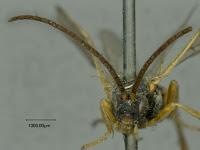The Committee on the Status of Endangered Wildlife in Canada (COSEWIC)
exists to provide Canadians and their governments with advice regarding
the status of wildlife species that are nationally at risk of extinction
or extirpation. Its committee of experts assesses and designates which wildlife species are in some danger of disappearing from the national territory. As part of its work, COSEWIC produces a Candidate List of species. I strongly recommend to anyone interested in the protection of the Canadian nature to visit the COSEWIC website, and to support their work and that of similar organizations. [Disclaimer: I do not work for COSEWIC, nor I am involved with their efforts in any capacity].
My interest in COSEWIC, and the reason I am writing this post today is to discuss the POSSIBILITY of including a parasitoid Braconidae wasp within their list. Is that a real thing? Or am I just getting too excited with my subject of research?
Let's look at the facts and try to be impartial. COSEWIC List includes quite a few arthropods species. Which in itself is something truly amazing, especially in this world that usually focus its conservation efforts in large, charismatic fauna -conservation efforts also prioritize the flora, but I will leave plants out of this comment and will restrict myself to animals for the time being.
Small animals, like insects, tend to be almost completely overlooked... unless they are "charismatic" by themselves, e.g. a beautiful butterfly, a conspicuous bumble bee, a colorful ground beetle, a large dragon fly, etc. But a small parasitoid wasp (2.5 mm long)... are you kidding me? Who cares about THAT?
Small animals, like insects, tend to be almost completely overlooked... unless they are "charismatic" by themselves, e.g. a beautiful butterfly, a conspicuous bumble bee, a colorful ground beetle, a large dragon fly, etc. But a small parasitoid wasp (2.5 mm long)... are you kidding me? Who cares about THAT?
Well, as they say "no harm in trying", and I am trying today to present the case for a first parasitoid wasp to be considered by COSEWIC: the microgastrine species Apanteles samarshalli Fernández-Triana, 2010.
The species was described very recently, in 2010, from specimens found mostly in southern Florida, United States (Everglades and the Florida Keys). I have also found additional specimens in two countries of Central America (data from unpublished studies).
But, the original description also recorded the species from one Canadian locality: Rondeau Provincial Park, in southwestern Ontario. Rondeau truly honours its reputation of having species commonly found at much southern latitudes, because the single specimen collected there (in August of 1973, and deposited in the Canadian National Collection of Insects, Ottawa) happens to be, by far, the northernmost known for the species.
But, the original description also recorded the species from one Canadian locality: Rondeau Provincial Park, in southwestern Ontario. Rondeau truly honours its reputation of having species commonly found at much southern latitudes, because the single specimen collected there (in August of 1973, and deposited in the Canadian National Collection of Insects, Ottawa) happens to be, by far, the northernmost known for the species.








